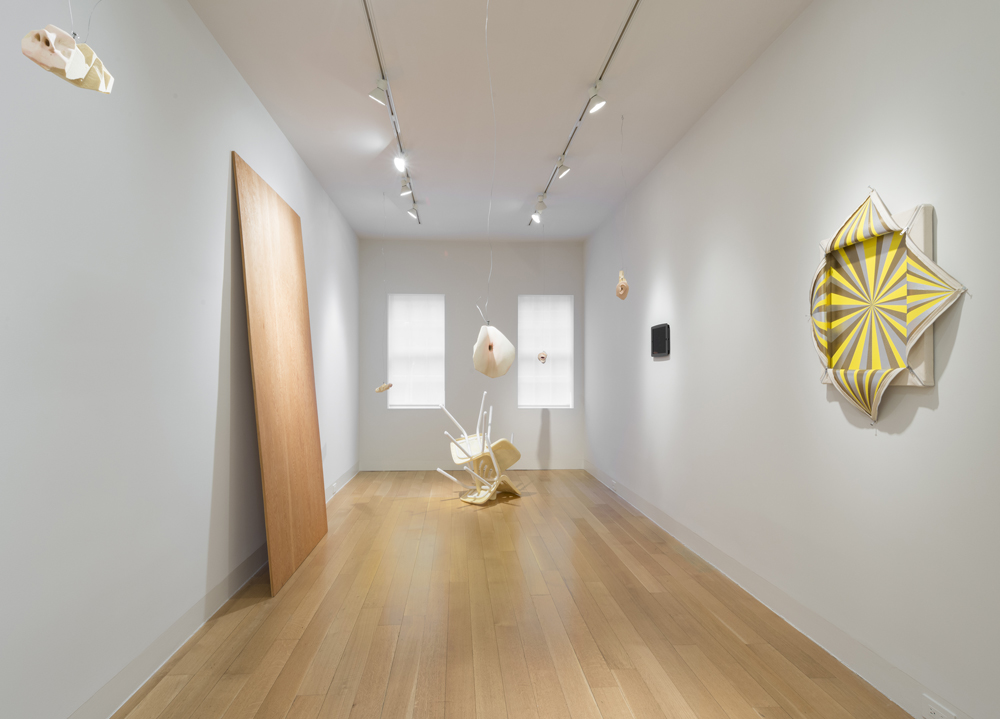In the Making
Luxembourg & Dayan, New York, USA
Luxembourg & Dayan, New York, USA

I once asked the abstract painter and anarchist Ben Morea why he lent Valerie Solanas the gun she used to shoot Andy Warhol. ‘Because he was destroying art!’ Morea cried, as if it were the most obvious thing in the world. I have always treasured this as a moment of absolute generational incomprehension. But, while standing on the second floor of ‘In the Making’ – a show linking the works of artists with their assistants, past and present – in front of paintings by Warhol alongside those of George Condo and Ryan Sullivan, I began to see how Morea might have felt the way he did. In his Television Silkscreen (Howdy Doody/Mr. Howell) (1998), Condo uses the multiple silkscreen technique, which he learned on the Factory line, to riff on Warhol’s diamond-dusted Howdy Doody (1981). In such company, Sullivan’s hard-plastic street trash Untitled (2016), composed of urethane plastic, epoxy resin, carbon fibre and aluminium, seems to embody the triumph of Warhol’s populism – not as a moment of liberation but as the collapse of a vital and necessary tension between the sacred and the profane.
The show’s press release claims that, by ‘pairing works by artists who have shared studio space at some point and engaged in working relationships’, it ‘suggests the social and intellectual interactions that fuel the production of art’ – interactions that ‘exert remarkable influence’. This understates how shockingly rich the conceit proves in its execution. Because sharing studio space signifies nothing too specific, resemblances suggest influences that we would never have imagined. The exhibition might be the most pleasant surprise I’ve had as a critic.

The show opens with three simple works by Robert Rauschenberg from 1974: embossed paper pressed tightly over cardboard, such that the outline shines through. In the middle work, the cardboard juts from beneath the paper. It is covered with tape and stamps, communicating so much of the strange intensity with which the past collects itself on a Rauschenberg. All lived particularity, his work always appears to have travelled from somewhere, survived somehow. This aesthetic recurs in a Brice Marden monochrome (Untitled, 1970) and two Dorothea Rockburne paintings (Study for Scalar D and Study for Scalar C, both 1970); finally, in Carrol Dunham’s Untitled (1984), time, abstraction and process combine beautifully to form what feels like a distilled composite of the three adjacent works.

Upstairs, Ross Bleckner’s Burn Painting (2015) and Eric Brown’s Lagoon (2015) support Richard Prince’s utterly preposterous Untitled (Rasta) (2011–14). Prince, who has always looked for the place where lifestyle and obscenity meet, humiliates where Warhol was content to patronize. He suggests that white appropriation of Rastafarian culture is just like drawing smiley faces on photographs of black people, which is what he does here. It’s difficult to watch Prince savage the gentle (we thought!) affection popular culture has for Rasta, found everywhere from William Gibson’s novel Neuromancer (1984) to the Matrix trilogy (1999–2003), and not feel slapped around a little. Bleckner’s simple burn technique and Brown’s haiku-like print steady Prince just long enough for us to understand the critique he is

On the third floor, this aggressive, conceptual call-and-response occurs between more harmonious counterpoints organized around colour and shape. Jack Goldstein, Ed Kienholz, Margaret Lee and Cindy Sherman present round, empty vessels in orange and red, while sculptures by Urs Fischer, Donald Moffett and Banks Violette somehow sexualize Robert Gober’s Plywood (1987).

As a curatorial conceit, ‘In the Making’ is so successful at drawing aesthetic associations that it would be fascinating to see it restaged on a much larger scale. Who knows what other sorts of crazy connections might form when we see who’s been working for whom?























